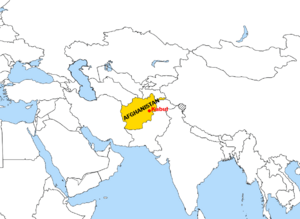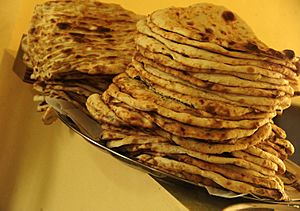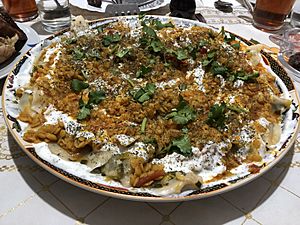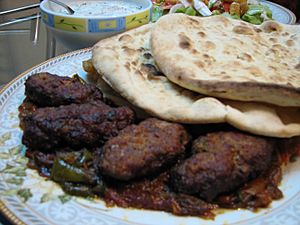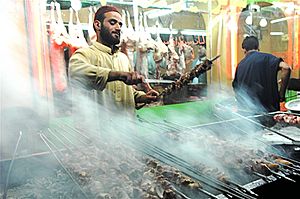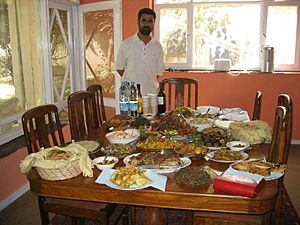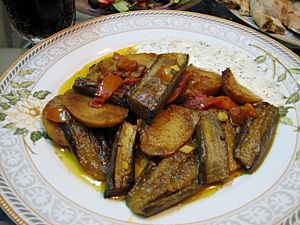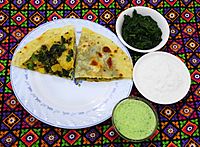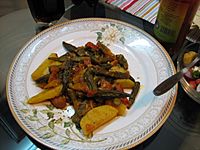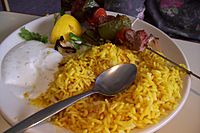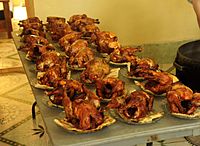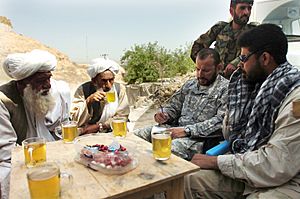Afghan cuisine facts for kids
Afghan cuisine (Pashto: افغان پخلی, romanized: Afghan Pakhlai, Dari: آشپزی افغانی, romanized: Āshpazi-e Afghāni) is influenced by Persian and Central Asian cuisine due to Afghanistan's close proximity and cultural ties. The cuisine is mainly based on Afghanistan's main crops, such as wheat, maize, barley, and rice. Accompanying these staple grains are native fruits, vegetables, and dairy products, such as milk, yogurt, whey, pomegranates, grapes, and sweet melons. Most of the people's diet revolve around rice-based dishes, while naan bread is consumed with most meals. Tea is generally consumed daily in large quantities, and is a major part of hospitality. The culinary specialties reflect the nation's ethnic and geographic diversity. The national dish of Afghanistan is Kabuli palaw, a rice dish cooked with raisins, carrots, nuts and lamb or beef.
Contents
Background
The cuisine of Afghanistan has elements from various places, for example chillies or garam masala from India, coriander and mint from Iran, dumplings and noodles from Uzbekistan and China, kebabs from Turkey and Arabia, and palaw from Central Asia. The similarities can be seen in the use of spices like cumin and cinnamon (as in Indian cuisine), green cardamom flavors (as in Chinese tea), and kebabs and yoghurts (as in Turkish and Arabic cuisines).
Staple foods
Rice
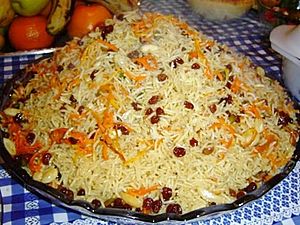

Rice is a core staple food in Afghan cuisine and the most important part of any meal.
Challow, or white rice cooked with spices, is served mainly with qormas (korma: stews or casseroles).
Palaw is cooked similarly to challow, but a combination of meat, stock, qorma, and herbs are also mixed in before baking, resulting in the elaborate colors, flavors, and aromas from which the rice got its name. Sometimes caramelized sugar is used to give the rice a rich brown color. Examples of palaw include:
- Kabuli palaw (the national dish) – meat and stock are added, plus a topping of fried raisins, slivered carrots, and pistachios
- Yakhni palaw – meat and stock are added to give the rice a brown color
- Zamarod palaw – spinach qorma is mixed in before the baking process, hence zamarod, meaning "emerald"
- Bore palaw – lawand is added giving the rice a yellow color
- Landi palaw – a traditional meal of rice (with stock made from chicken or mutton that has been salted and dried in the sun)
- Bonjan-e-roomi palaw – bonjan-e-roomi (tomato qorma) is added during baking giving the rice a red color
- Serkah palaw – similar to yakhni pulao, but with vinegar and other spices
- Shibet palaw – fresh dill and raisins are added during baking
- Narenj palaw – a sweet elaborate rice dish made with saffron, orange peel, pistachios, almonds, and chicken
- Maash palaw – a strictly vegetarian sweet-and-sour pilaf baked with mung beans, apricots, and bulgur wheat
- Alou balou palaw – a sweet rice dish with plums and chicken
Bread
Naan is a type of flat-bread cooked in an oven made from a hole in the ground. The bread is slapped onto a stone wall to cook. Other varieties include naan-e-Afghan/naan-e-tandoori (a type of Afghan bread cooked in a vertical ground clay oven or a tandoor) and naan-e-tawagy (flatbread cooked on a flat pan), among others.
Major dishes
Steamed dumplings
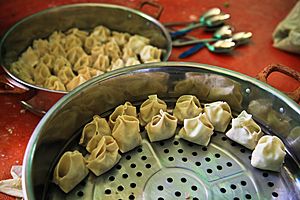
There is a wide variety of dumplings. Known under the name khameerbob and often eaten as dumplings, these native dishes are popular. Due to the long time required to make the dough for the dumplings, they are rarely served at large gatherings, such as weddings. They are instead served on special occasions at home.
- Aushak – dumplings filled with a mixture consisting mainly of leeks, topped with either garlic-mint qoroot or a garlic yogurt sauce, sautéed tomatoes, red kidney beans, and a well-seasoned ground-meat mixture (It is a dish associated with Kabul, the capital of Afghanistan.)
- Mantu – steamed dumplings filled with onion and ground beef or lamb, usually topped with a tomato- and yogurt- or qoroot-based sauce and then garnished with dried mint and coriander (The yogurt-based topping is usually a mixture of yogurt, garlic, and split chickpeas. The qoroot-based sauce is made of goat's cheese and also mixed with garlic; a qoroot and yogurt mixture will sometimes be used.)
Qormah
Qormah (also spelled "korma" or "qorma") is an onion- and tomato-based stew or casserole usually served with challow rice. First, onion is caramelized, for a richly colored stew. Then tomato is added, along with a variety of fruits, spices, and vegetables, depending on the recipe. The main ingredient, which can be meat or other vegetables, is added last. There are hundreds of different types of qormahs including:
- Qormah e gosht (meat qormah) – usually the main qormah served with palaw at gatherings
- Qormah e alou-bokhara wa dalnakhod – onion-based using veal or chicken, sour plums, lentils, and cardamom
- Qormah e nadroo – onion-based, using lamb meat or veal, yogurt, lotus roots, cilantro, and coriander
- Qormah e lawand – onion-based, using chicken, lamb, or beef, plus yogurt, turmeric, and cilantro
- Qormah e sabzi – lamb, sautéed spinach, and other greens
- Qormah e shalgham – onion-based using lamb, turnips, and sugar (sweet and sour taste)
Kabob
Afghan kabob is most often found in restaurants and at outdoor street vendor stalls. Most of the time, it contains lamb meat. Kabob is made with naan instead of rice. Customers have the option to sprinkle sumac or ghora (dried ground sour grapes) on their kabob. Pieces of fat from the sheep's tail (jijeq) are usually added to the skewers to add extra flavor.
Other popular kabobs include the lamb chop, ribs, kofta (ground beef), and chicken.
Chapli kebab, a specialty of eastern Afghanistan, is a patty of minced beef. It is a popular barbecue meal in both Pakistan and Afghanistan. It is prepared flat and round and served with naan. The original recipe of chapli kabob dictates a half meat, half flour mixture which renders it lighter in taste and less expensive.
Chicken
Afghan chicken or Murgh Afghani is a classic example of one of the most famous dishes of Afghanistan. Chicken dishes are usually found in restaurants and at outdoor street vendor stalls. Unlike in the Indian cooking style, chicken in Afghan cuisine is often used with the intention that it be halal. Cream, butter, and curd are customary ingredients in all chicken recipes, whether served as an appetizer or a main course.
Quroot
Quroot (or qoroot) is a reconstituted dairy product, traditionally a by-product of butter made from sheep's or goat's milk. The residual buttermilk remaining after churning butter is soured further (by keeping it at room temperature for a few days), treated with salt, and then eventually boiled. The precipitated casein is filtered through cheesecloth, pressed in order to remove liquid, and then shaped into balls; the product is thus a hard and very sour cottage cheese. Though it can be eaten raw as a savory snack, it is typically served with cooked Afghan dishes such as aushak, mantu, and kichri qoroot.
Miscellaneous
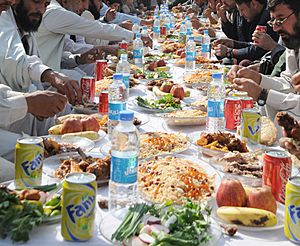
- Afghan Kofta (meatball)
- Afghan salad
- Afghani burger
- Aush (hand-made noodles)
- Bichak (small turnovers with various fillings, including potato and herbs, or ground meat)
- Dolma (stuffed grape leaves)
- Londi, or gusht-e-qaaq (spiced jerky)
- Kichri (sticky medium-grain rice cooked with mung beans and onions)
- Badenjan (cooked eggplant with potatoes and tomatoes)
- Badenjan-Burani (fried slices of eggplant, topped with a garlic sour cream sauce and sprinkled with dried mint)
- Baamiyah (okra)
- Bolani also called “Buregian” in southern Afghanistan (somewhat similar to a Quesadilla)
- Halwaua-e-Aurd-e-Sujee
- Osh Pyozee (stuffed onion)
- Dampukht (steamed rice)
- Bonjan Salad (spicy eggplant salad)
- Shor-Nakhud (chickpeas with special toppings)
- Maast or labanyat (type of plain yogurt)
- Chakida or chakka (type of sour cream)
- Shola Ghorbandi
- Salata (tomato and onion-based salad, often incorporating cucumber)
- Gosh e feel (thin, fried pastries covered in powdered sugar and ground pistachios)
- Kaddo Borwani (sweet pumpkins)
- Kebab (similar to Middle Eastern style)
- Mou-rubba (fruit sauce, sugar syrup and fruits, apple, sour cherry, or various berries, or made with dried fruits. "Afghan favorite is the Alu-Bakhara".)
- Narenge Palau (dried sweet orange peel and green raisins with a variety of nuts, mixed with yellow rice glazed with light sugar syrup)
- Nargis kabob (egg-based angel hair pasta soaked in sugar syrup, wrapped around a piece of meat)
- Torshi (eggplant and carrot mixed with other herbs and spices, pickled in vinegar and aged)
- Khoujoor (Afghan pastry, deep-fried, oval-shaped, similar to doughnuts in taste)
- Afghan Chatni made with fresh coriander leaves
- Kalah Chuquki or Kalah Gunjeshk (battered deep-fried bird heads)
- Kalah Pacha (lamb or beef head/feet cooked in a broth, served in bowls as a soup dish or in a stew or curry)
- Shami kabob (cooked beef blended with spices, flour, and eggs, and rolled into hot dog shapes or flat round shapes and fried)
- Chopan (Pashto/Persian: چوپان, meaning "shepherd") kabob (Pashto/Persian: کباب) (lamb chops skewered and grilled on charcoal)
- Delda or Oagra (mainly a Southern dish, whose main ingredient is a mixture of split wheat and a variety of beans)
- Owmach (made from flour; a soup-like dish, very thick and pasty)
- Maushawa (mixed beans and tiny meatballs, served in a bowl)
-
Cooked okra is also served for lunch or as a side dish
-
Afghan lamb kebab with yellow saffron rice
Desserts and snacks
- Sheer Yakh, a traditional dessert
- Sheer khurma, a traditional dessert
- Sheer Berinj (rice pudding)
- Cream roll (pastry)
- Baklava (pastry)
- Afghan Cake (similar to pound cake, sometimes with real fruit or jelly inside)
- Fernea, sometimes spelled feereny, (milk and cornstarch help make this very sweet, similar to rice pudding without the rice)
- Kulcha (variety of cookies, baked in clay ovens with charcoal)
Soups
- Shorba (Afghan soup similar to borscht)
- Shorwa-E-Tarkari (meat and vegetable soup)
- Peyawa or Eshkana (a soup based on flour, very similar to a gravy, but mixed with chopped onion, potatoes, and eggs)
- Aushe Sarka (vinegar-based flat noodle soup, tastes very similar to Chinese hot and sour soup)
Drinks
Doogh
Doogh (also known by some Afghans as shomleh or shlombeh) is a cold drink made by mixing water with yogurt and then adding fresh or dried mint. Some variations of doogh include the addition of crushed or diced cucumber chunks. It is the second most widely consumed drink in Afghanistan (the first being tea), especially during lunchtime in summer. Doogh can be found at almost every Afghan grocery store and is served in restaurants.
Tea
Tea in Afghanistan is called chai, which can either be green or black. It is consumed at all times, especially a short time after finishing a meal or with guests during any social gathering. Most people drink green tea with no sugar. Some add saffron, sugar or cardamom.
Sheer chai (which translates from "milk tea") is also consumed but mostly in the morning and on special occasions. It is a type of Kashmiri chai. Many people of Afghanistan also drink masala chai, particularly in cities such as Asadabad, Jalalabad, Khost and Kandahar.
Eating habits
Sub-cuisines
While Afghans have a common cuisine, certain ethnicities form sub-variations of it.
Pashtun cuisine
Pashtuns are the largest ethnic group of Afghanistan, constituting about 42% of the country's total population. A major dish in Pashtun culture is Sohbat, found at traditional gatherings and events. Other major Pashtun dishes include lamb-skewered sajji and chapli kebab. The name dampukht stands for steamed meat, and Khaddi kebab is the Afghan shashlik, which is grilled on an open fire, on a spit.
Although it differs from region to region, Pashtun cuisine is meat-heavy and often includes caramelized rice. For example, the dish known as bolani in the north and east is often called borogyen in the south and west of Afghanistan.
Common summer beverages include shlombeh, also known in Persian as doogh, a drink consisting of liquid yogurt, mint, and bedreng (Afghan cucumber). Sherbet is an ice-sugared cold drink. Sheer yakh is a sweet ice-like product, literally translating to "cold milk".
Hazara cuisine
The Hazara people in central Afghanistan (in the region of Hazarajat) and western Pakistan (Balochistan province) have their own fare. The Hazaragi cuisine shares some similarities with neighboring regional cuisines, so it is mainly influenced by Central Asian, Persian, and South Asian cooking. However, cooking methods vary in some of the dishes of these neighboring cuisines.
Dining etiquette
Traditionally, dinners are held on a tablecloth on the floor, which is called the dastarkhan. Meals are normally eaten with the right hand. After a meal, tea with dessert is served.
Special occasions
Serving tea and white sugared almonds (called nuql) is customary during Afghan festivals.
See also
 In Spanish: Gastronomía de Afganistán para niños
In Spanish: Gastronomía de Afganistán para niños


